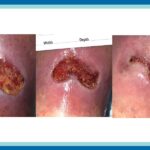When an injury where a break in the skin occurs and a fresh wound is the result, certain physiological steps typically occur that move the wound to complete healing.
Wounds certainly aren’t pleasant to look at, especially if we’re squeamish. That stated, visualizing a wound is an ongoing and important part of managing the process to ensure healing takes place in a timely and orderly fashion.
Knowing what to look for in a healing wound is critical, since if a wound is not progressing and has stalled, the delay may result in more serious complications.
Let’s examine how wounds heal, using color as our guide. Focusing on 3 colors and their related shades can help us recognize if a wound is healing or if more aggressive intervention is required.
COLOR GUIDE
RED: An open wound with predominantly red tissue within the base is likely moving towards healing. The red base means that healing is occurring, and that adequate blood flow and oxygen are being delivered. One caveat is that excessive red color surrounding the wound may be an indication of infection (cellulitis). Mild redness is often associated with increased metabolic activity and is not a concern, but intense red that may be accompanied by pain requires medical attention.
YELLOW: wounds that have stalled in the healing process often have the presence of bacterial colonies known as “biofilm”. Biofilm is often not visible, but in some cases, a thick yellow to white fibrinous debris can be found along the base of a wound which can represent a biofilm colonization. Biofilm does not mean an infection is present, but it does mean that the wound is not going to heal unless more aggressive care is rendered. One additional note is that biofilm is not pus, and the presence of thick or foul-smelling drainage such as pus should be evaluated by medical personnel without delay.
BLUE: the presence of blue or dusky tissue either within or surrounding the wound is a sign that not enough oxygen is reaching the site. This may also be a sign of blockage in an artery that supplies the area. Any time a wound is blue or dusky, immediate medical attention must be sought.
BEYOND THE PRIMARY COLORS
GREEN: The presence of green does not mean that gangrene is present! Green within or surrounding the wound is often associated with an odor and a bacteria that thrives in moisture. The bacteria are known as Pseudomonas aeruginosa. Pseudomonas is a very common bacterial organism, and its characteristic green color does not necessarily mean the wound is infected, but it does mean the wound needs to be cleaned aggressively as infection could be imminent. Regardless, the presence of heavy bacterial colonization will delay wound healing.
PINK: Pink color (or a very pale red) can also indicate a stalled wound. Pink color is often seen in chronic venous ulcers or in diabetic/neuropathic foot ulcers. These types of wounds, although not related causally, share the common characteristic of taking months or sometimes years to heal, if healing is possible. Sadly, these types of wounds can begin innocently, the result of minor trauma, and as a result, give the impression they can managed and will heal easily. Anyone with a history of diabetes or venous disease (deep venous thrombosis, varicose veins, or a family history of chronic venous insufficiency) who develops a wound of the leg or foot that does not resolve within 2 weeks, should seek treatment with a wound specialist. Those who have had a prior history of venous or diabetic foot ulcer, who develop a new wound, should seek immediate attention.
BLACK: Black (or gray) in wounds is never a good sign. Often, it is associated with necrotic or dead tissue. Once tissue is dead, it cannot be revived and must be removed from a wound for healing to occur. Removal of black tissue is a process called “debridement” and can be performed in a variety of ways, ranging from topical dressings to surgical debridement. Most importantly, the presence of necrotic tissue means bacteria is present in excessive amounts and infection, ranging from localized to systemic, is impending, if not already present. Black tissue means also that no blood flow has reached a portion or all the wound, and gangrene may also be impending. Depending upon the extent of the necrotic tissue, this can be a medical emergency. Regardless of extent, black in or around a wound must be evaluated quickly and without delay.
CONCLUSON: If you are at high risk due to underlying health issues, and you develop a wound, it is better to err on the side of caution. Seek treatment as soon as possible, preferably with a wound specialist. Attempting to manage a wound with over the counter or home remedies can also lead to disaster in the high-risk individual. Be safe. Time is of the essence and any delay in obtaining proper treatment may reduce the likelihood of a favorable outcome.


